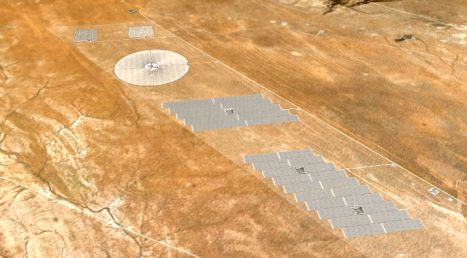Are gargantuan PV projects the key to the solar industry's future?
The global solar industry is volatile, but it grows significantly every year. It's quick to adapt to changing markets, technologies and trade obstacles. The prospect of solar becoming a 100-gigawatt-per-year market is not a matter of "if" but "when."
However, if the IPCC’s latest assessment of widespread economic damage from climate change is correct and humanity is hoping to make a dent in decarbonizing its energy mix, then solar and renewables have to be installed on a much bigger scale. Replacing the thousands of gigawatts of coal- and gas-burning plants on this planet will require many thousands of projects at the scale of say, the 550-megawatt Topaz PV farm or the 290-megawatt Agua Caliente PV plant.
So, if the aim is to grow big and fast, it makes sense to imagine huge multi-gigawatt projects that address the scale problem head-on with really big centralized solar.
Here are three proposed (or perpetually proposed) monster solar projects that align with this vision.
4 Gigawatts From India's Ultra Mega Solar Power Project
Image: India's Sambhar Salt Lake
Five acronymic Indian entities (BHEL, SECL, SSL, POWERGRID, SJVN and REIL) recently signed an "historic" memorandum of understanding to build a 4,000-megawatt solar power plant in India's state of Rajasthan near Jaipur, close to the briny Sambhar Salt Lake.
(Incidentally, Shyam Mehta, GTM Research's lead upstream solar analyst, describes "memorandum of understanding" as the "most misleading, vacuous phrase that could exist.")
The proposed plant is to be built in two phases over seven years with a 1,000-megawatt first phase, according to The Climate Group. The organization reports that the first construction phase will cost $1.08 billion, and that the developers have approached the World Bank for a $500 million loan to begin the first 750 megawatts.
India added more than 1 gigawatt of solar power to its grid in 2013, bringing total solar capacity to 2.18 gigawatts, according to data from the government of India's Ministry of New and Renewable Energy. The country has a solar target of 10 gigawatts by 2017, 20 gigawatts by 2022 and 200 gigawatts by 2050.
Fluor and the $22 Billion, 5-Gigawatt South African Project

Image: Artist's rendering of South African Solar Park, which includes PV and CSP technologies
A 317-page report on a proposed 5-gigawatt solar park in South Africa's Northern Cape Province was authored by EPC Fluor in 2011, along with a flurry of early feasibility studies for the country's Department of Energy. The Upington region was selected as a suitable site although it "does not have an established transmission network," according to the report. Few grids would be able to support this type of generation source without extensive transmission upgrades.
The South African government estimated the cost of the project at $22 billion in 2011. We've asked Fluor and the South African Department of Energy whether any progress has been made since then.
Desertec's Hundreds of Gigawatts
Desertec envisions a pan-African-Euro-MidEast grid powered by hundreds of gigawatts of centralized PV, CSP, wind and other renewables. The nonprofit foundation accepts PayPal if you're keen on donating -- which is in itself an indication of how the project is progressing.

Centralized or Distributed?
In the U.S., huge centralized generation projects are more difficult to finance, permit and integrate into the grid compared to smaller distributed generation projects. Regulatory and political headwinds also stall giga-scale projects.
But what about India or North Africa? Should these regions move their capital into giga-scale projects or point capital to distributed generation and grid edge solar?
Chandra Bhushan, deputy director general of the Delhi-based nonprofit Centre for Science and Environment, responded to the India project with a declaration for distributed generation:
"We have singularly failed in providing access to adequate, affordable and clean energy to a large section of the country’s population. As per the 2011 Census, one-third of households -- about 400 million people -- do not have access to electricity. In rural India, about 45 percent of households -- more than 77 million -- continue to use kerosene to light their homes and shops. With no access to any source of lighting, 1.2 million households go dark after sunset. The country is paying huge development costs because of this energy poverty. Education, health and economic development are getting stymied."
Bhushan asked: "In such a scenario, should we invest in large and expensive solar power plants that will feed electricity into a leaking grid (the T&D loss in the country was 24 percent in 2011-12) and provide subsidized solar electricity to the rich domestic, commercial and industrial consumers? Or should we invest in small solar power plants and local (mini) grids that can provide electricity to the energy poor?"
While these projects sit on the shelf waiting to get developed, people in need of electricity are getting served by a growing roster of off-grid solar companies. Will that trend continue? Or can the mega-plant ever win?



